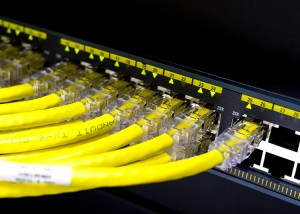Edge computing technologies exploit data as close as possible to its source. By deploying computing capacities at the edge of the network, they enable the emergence of new, more efficient and more responsive services, and are attracting growing interest from energy players. While the energy transition implies a decentralisation of the operation of the electrical system, edge computing thus opens up new prospects for the development of smart grids.
A webinar organised by the Think Smartgrids association provided an overview of the various applications of edge computing and its potential for electricity networks.

Over the last few decades, sensors have multiplied in our environment, with the aim of collecting data which, once aggregated and analysed, can provide new services to an industry or a ‘smart’ building. It is difficult to precisely define the contours of edge computing as this technology is evolving so fast, but as Philippe Lalanda, a professor at the University of Grenoble, explains, its major contribution has been to allow the data from these sensors to be processed on devices at a local level instead of being sent up to the cloud. The benefits are multiple: an almost non-existent latency between the transmission and processing of the data, which improves performance, a reduction in the costs linked to the cloud and the means of telecommunication, less private data being sent back up, better resilience in the event of a cloud failure, the use of network resources that were previously under-utilised, and lastly, new services thanks to the pseudo-real-time processing of the data. The downside is that the complexity is much greater, both in terms of the new software architectures and applications that need to be developed, and in terms of having to manage locally everything that was outsourced in the cloud, particularly data processing.
However, edge computing is already well established in electrical networks. Questioned by Michel Béna, deputy director of R&D at the French electricity transmission operator RTE, the speakers gave a non-exhaustive overview of concrete use cases already at work.
Jacques Martin, EU R&D Manager at Atos Worldgrid, spoke about the SMAP and AI4DG projects, which aim to integrate renewable energies (in particular rooftop photovoltaic panels), electric vehicles and battery storage into the low-voltage grid on a much larger scale. Voltage variations and in particular overvoltages in the event of too much renewable energy being injected into the network pose a real challenge to network managers.
The SMAP project tested the local processing, at the concentrator level, of data transmitted by Linky meters relating to electrical quantities at the distribution points, particularly data relating to voltage excursions. An algorithm installed in the concentrators within the source stations ensures the real-time processing of this information. The algorithm can intervene on the one hand by controlling the inverters of the photovoltaic panels and on the other hand by provoking the modification of the on-load regulators at the level of the transformers.
The Franco-German AI4DG project takes the complexity of the task a step further by integrating electric vehicles (some of which are equipped with bi-directional chargers) and battery storage into the equation, targeting two points of optimisation. The first, behind the meter, within the home, seeks to maximise self-consumption and minimise household electricity bills without sharing details of load or consumption curves with the outside world. The approach adopted combines edge computing, traditional optimisation and artificial intelligence. The second is at the source station level and is based on aggregated predictions to develop simple signals for homes and to allow the injection or consumption of energy to be postponed.
Guillaume GIRAUD, R&D engineer for Future Architectures for the control of the electrical system at RTE, presented the “NAZA” or New Adaptive Zone Automata project. Thanks to sensors deployed on the transmission network and predictive control algorithms installed at local grids on a few electrical substations, RTE automatically manages congestion on its transmission network in areas where renewable energy is developing rapidly. The network control architecture has been completely rethought, and RTE is aiming for a continuum between control at the cloud level and at the substation level, with an automatic switchover of functions that will make it possible to gain agility and resilience.
This use of edge computing will enable RTE to optimise the development of its network, and thus to develop it as closely as possible to real needs, with an expected gain on its network investments of €7 billion out of the €37 billion targeted by 2035 and significant savings in resources, particularly in critical materials such as copper.
The French DSO Enedis also has multiple applications for Edge computing technologies. Stéphanie Delaunay from the Data Division of the IT Department presented the benefits of Edge computing for the detection of power outages on the low voltage network. Edge technologies are deployed in the concentrators of the smart meter Linky infrastructure located in all the MV/LV substations in the territory covered by Enedis. This automatic and local processing enables the detection of power cuts even before the user calls the customer service. The alarms only go into the cloud of Enedis’ central IT service in the event of a problem. Another advantage of the Edge used by Enedis is that the local processing of data helps to remedy the problem of white zones when teams are working in the field.
However, Stéphanie Delaunay mentions a cybersecurity issue: the lack of human supervision of the equipment in the field, which prompted Enedis to set up a dedicated security module to detect possible physical attacks, report the information and even automatically block the operation of the concentrator.
Clément Paris, R&D project manager at EDF, finally spoke about the future dimension of edge computing for networks. The electricity company EDF is indeed very interested in the potential of these technologies to face the growing challenges of the electricity system (development of renewable energies and new uses, decentralisation, extreme climatic events, etc.). The applications envisaged for edge computing thus relate in particular to the dimensions of resilience and improved data analysis, but also to the development of flexibilities, cybersecurity and new intelligent functions in electrical substations.
However, Clément Paris underlines the real industrial challenge raised by the deployment of edge computing on networks and the multiplicity of skills that this requires, in terms of data science, AI, development of information systems and applications, among others. It calls on the smart grids sector to co-develop these new services and information systems, as well as to work on certification and standardisation issues.
Watch the webinar (in FRENCH): : https://www.youtube.com/watch?v=GdlfdI9AJaU&ab_channel=ThinkSmartgrids



